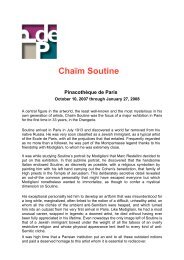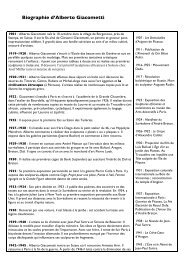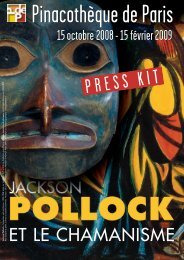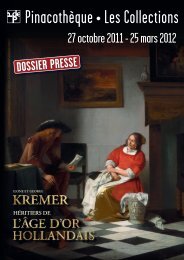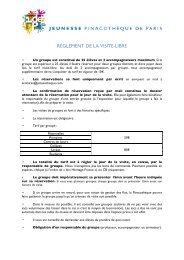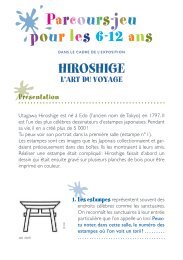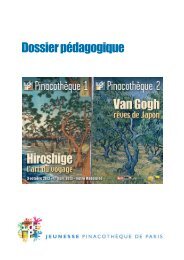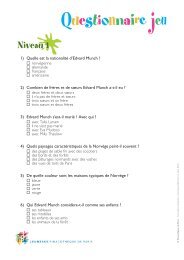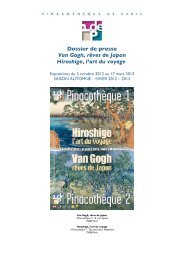Download - Pinacothèque de Paris
Download - Pinacothèque de Paris
Download - Pinacothèque de Paris
Create successful ePaper yourself
Turn your PDF publications into a flip-book with our unique Google optimized e-Paper software.
Picasso and Braque. He takes a course in sculpture and, using a homema<strong>de</strong><br />
electric kiln, begins to create animal forms in ceramic and enamel. In 1942,<br />
Lichtenstein enrolls in Professor Hoyt L. Sherman’s Drawing by Seeing course<br />
where stu<strong>de</strong>nts sit in the dark and are expected to draw objects that have been<br />
set up or suspen<strong>de</strong>d in the middle of a room and flashed with light for just a<br />
second. Sherman’s theories on “organized perception” or visual and perceptual<br />
unity form the basis for Lichtenstein’s work from that point forward.<br />
In February 1943, Lichtenstein is drafted into the United States Army and leaves<br />
OSU to report for active duty. As part of his military training, his unit is enrolled<br />
at De Paul University in Chicago, Illinois, and he takes courses in engineering.<br />
Following the completion of this Army Special Training Program, he goes to<br />
Biloxi, Mississippi, where he briefly enters a pilot/navigator-training program,<br />
which is then canceled. In a subsequent assignment, as a clerk and draftsman,<br />
he enlarges cartoons from the Army newspaper Stars & Stripes for his<br />
commanding officer. Due to the need for more combat soldiers overseas, in<br />
December 1944, Lichtenstein’s Engineer Combat Battalion is shipped to England<br />
and then to France, Belgium and Germany. He keeps a sketchbook and draws<br />
landscapes and portraits of other soldiers. Letters home evi<strong>de</strong>nce his buying of<br />
illustrated art books and a <strong>de</strong>sire for more paper and drawing materials during<br />
his overseas duty.<br />
By the fall of 1945, he gains entry to history and French-language classes at the<br />
Cité Universitaire in <strong>Paris</strong>. By December of that year, Lichtenstein is sent home<br />
because his father is gravely ill. In January 1946, following his father’s <strong>de</strong>ath,<br />
he receives an honorable discharge from the Army and is given the American<br />
Service Medal among other distinctions. In March of that same year, Lichtenstein<br />
returns to OSU and completes his Bachelor’s Degree in Fine Arts in June. His<br />
extant works from the time inclu<strong>de</strong> Precolumbian-styled sculptures carved from<br />
stone or done in terracotta or ceramic.<br />
Lichtenstein accepts a position as an art instructor at OSU in September 1946.<br />
Among the classes he teaches is Design 423 where he employs a “Flash Lab”<br />
similar to Sherman’s and asks stu<strong>de</strong>nts to draw the afterimage of objects hastily<br />
lit using big blocks of charcoal or crayon on newspaper. In January 1947, he<br />
enters the graduate program at OSU. The following year, Lichtenstein is<br />
inclu<strong>de</strong>d in a group show at an artists’ cooperative, the Ten-Thirty Gallery in<br />
Cleveland, where he meets his future wife, Isabel Wilson, the gallery assistant.<br />
He exhibits paintings of musicians, street workers, a racecar driver and even a<br />
<strong>de</strong>epsea diver that are composed of simple biomorphic shapes and drawn<br />
13



